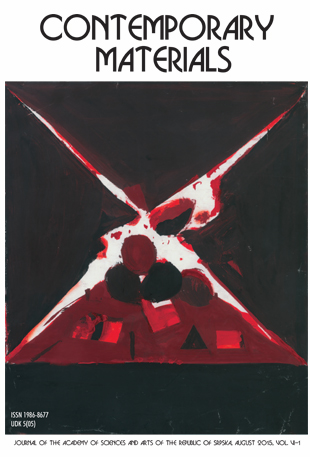THE INDOOR RADON AND THORON CONCENTRATIONS IN SCHOOLS OF SKOPJE (REPUBLIC OF NORTH MACEDONIA) AND BANJA LUKA (REPUBLIC OF SRPSKA) CITIES MEASURED BY RADUET DETECTORS
DOI:
https://doi.org/10.7251/COMEN2001020SAbstract
Radon (222Rn) and thoron (220Rn) are natural radioactive gases, generated in the terrestrial materials. They are the main sources of public exposure to ionising radiation in any of indoor environment worldwide. Differences in half-lives of 222Rn (T1/2 = 3.8 d) and 220Rn (T1/2 = 55.6 s) lead to its different indoor behavior. Several studies of indoor 222Rn and 220Rn in Northern Macedonia have been performed, starting with measurements in dwellings in 2008 and continuing with measurements in schools during 2012. The surveys in the Republic of Srpska began later (in 2011) with the simultaneous 222Rn and 220Rn measurements in the dwellings and schools of Banja Luka cities. This paper, as a result of our cooperation, summarizes the results and general conclusions obtained from 222Rn and 220Rn measurements in schools of capitals. In both cities, the measurements were made using Raduet - nuclear track detectors; deployed at distances: >0.5m (Skopje) and 0.2m (Banja Luka); and exposed in a period: March 2012 - May 2012 (Skopje) and April 2011 - May 2012 (Banja Luka). Results for 222Rn and 220Rn concentrations in both cities have a log-normal distribution. The 222Rn geometric mean value of 71 Bq/m3 in Skopje is higher than in Banja Luka city (GM = 50 Bq/m3). Among different radon potential in the cities, this difference could be related to the different exposure time of detectors. Furthermore, the dispersion of the 222Rn results in each city expressed through geometric standard deviation is relatively low: GSD = 2.13 (Skopje) and GSD = 2.11 (Banja Luka) indicating relatively homogeneous data sets. The 220Rn concentrations in Banja Luka (GM = 51 Bq/m3) were higher than in Skopje (GM = 11 Bq/m3). It is obvious that in the case of 220Rn, the exposure period did not play a significant role. One of the reasons for this difference could be the position of the detectors as well as the different building materials in the schools. On the contrary, the dispersion of the 220Rn results in Skopje (GSD = 3.38) was greater than in Banja Luka (GSD = 2.07).
Keywords: radon, thoron, gas, school.
